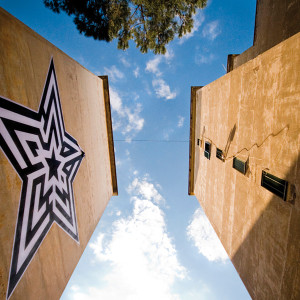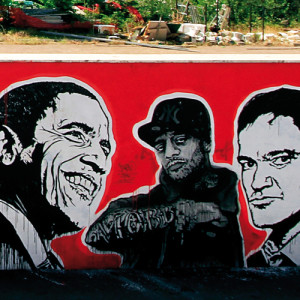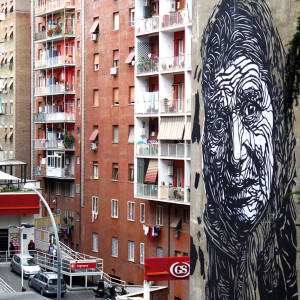loading data

2010
Un buon motivo per uscire di casa
Going big: la Street Art tra Neo-Muralismo e privatizzazione dello spazio pubblico
Si parla ormai a dismisura di Street Art. Ne parlano gli stessi artisti, i critici, i galleristi che la promuovono e i direttori di musei che gli dedicano delle mostre. Ne parlano infine i politici chiamati a definire normative per inquadrare un fenomeno del quale non è sempre facile percepire il senso e il valore. Nonostante tutto questo vociferare, pochi capiscono però se si debbano o meno incoraggiare interventi di Street Art volti a ricoprire delle facciate intere di palazzi in quartieri come Garbatella. Ad eccezione degli addetti ai lavori, l’abisso che separa la Street Art dal semplice atto vandalico non è ancora percepito in modo chiaro. Le polemiche attorno al processo attualmente in corso a Milano, per imporre a Bros il rimborso delle spese sostenute dal Comune per ripulire i muri dalle sue opere, dimostrano quanto le posizioni delle due parti – street artists, da una parte, e Stato inteso come collettività, dall’altra – siano ancora distanti. Per questo, non credo di esagerare se affermo che, almeno a Roma, esisteranno una fase pre e una fase post Outdoor. Negli ultimi anni, l’Italia è stata teatro di alcuni interventi di Street Art su edilizia abitativa realizzati con il sostegno delle istituzioni pubbliche. Tra questi, Outdoor è il primo a porre al centro della propria azione l’emergere di un nuovo rapporto tra la Street Art e il tessuto urbano, concentrandosi sul problema “visivo” generato dalle forme monumentali dei poster di Sten Lex, JBROCK, L’Atlas e C215. È difficile prevedere se questo festival permetterà alla Street Art di fare breccia nell’immaginario collettivo cittadino, ma di certo contribuisce in modo importante al dibattito politico, amministrativo e legislativo in corso da anni sulla presenza della Street Art nel nostro panorama urbano. Le ragioni che ci hanno portato a scegliere il poster e le dimensioni monumentali sono già state spiegate, ma altri parametri hanno avuto un peso importante nelle selezione degli street artists da coinvolgere. Volevamo qualità e stili diversi e pensiamo che Sten Lex, JBROCK, L’Atlas e C215 possano garantirci un risultato all’altezza delle nostre aspettative. Gli abbiamo chiesto di lavorare in bianco e nero per ottenere un’unità cromatica e per facilitare l’osservazione della ricchezza e del potenziale ancora nascosto nella Street Art. Qualche anno fa, su un muro campeggiava la scritta “Roma è un cimitero che scoppia di salute”. Tanto vale allora provare a fermare l’emorragia creativa che obbliga ogni anno molti giovani artisti romani a partire all’estero. Dal 2006, il miglior modo per contrastare questo fenomeno è sembrato nufactory quello di censire gli artisti presenti sul territorio, coinvolgerli in progetti espositivi e proporgli un percorso di crescita che speriamo possa prevedere nuove occasioni di confronto con nomi del panorama artistico internazionale come per Outdoor. Roma sembra risvegliarsi: aprono i MAXXI, aprono i MACRO, aprono nuove gallerie, ma tutt’altra cosa sono e saranno sempre quei fermenti che vengono dal basso.
Testo di Christian Omodeo
_________________________________________
Going big. Street Art: in between a neo-muralist movement and privatisation of public spaces
Street Art is excessively spoken about nowadays. The artists themselves, the critics, the galleries that promote it and the museum directors that dedicate exhibitions to it, are all talking about Street Art. And finally so do politicians; called to outline regulations to define a phenomenon that isn’t very easy to assign a value to and to make sense of. Notwithstanding all these rumours, not everybody understands why we should or shouldn’t be promoting Street Art events such as the one intending to cover the façade of a whole building in a neighbourhood like Garbatella. Apart from the people working inside it, the abysmal difference that separates Street Art with vandalism acts is not widely perceived as clear. The polemics surrounding the court hearing currently going on in Milan, which is seeking to make Bros pay for the expenses faced by the town council to remove his works from the walls around the city, demonstrate how distant the two parties still are; with streets artists on one side and the State – intended as a collective – on the other. For this reason I think it not exaggerated to say that, at least in Rome, there will be a pre and post-Outdoor era. In the last few years Italy has seen Street Art events taking place on residential buildings and supported by public institutions. Street Art is often accused of unlawfully occupying the walls of our cities, but this doesn’t take into account that its unauthorised presence actually serves to expose the visual pollution in the urban landscape of our cities, invaded by advertisement boards. From this point of view, Rome is an exemplary case of the siege its streets and building are constantly exposed to. Even without taking into account the 6×3 advertising posters that appear from nowhere during the night, there isn’t a square in the city that hasn’t long been taken over by scaffolding draped with huge adverts. The obelisks have for years been subject to a campaign which appears to be aiming at completely removing them from the urban landscape. Buses, trams and now even Smart cars: there isn’t a surface in Rome unaffected by this advance. This is why an exhibition like Outdoor gains additional value by being organised in an environment such as the Italian capital. The choice of the poster as a medium, the monumental size of the opera, the ordinary building on which it is realised, are not accidental; these are choices intended to recall the volatile nature of advertisement installations. Each detail is an invitation to reflect on the values in our society that allow us to think that the image of a housewife holding a packet of pasta, is less controversial than a Street Art intervention. Pay attention here, because this is the difference between Outdoor and other ventures like the recent Absolut Wallpaper painted by Ozmo at the Ex-Mattatoio. Without wanting to take anything away from the quality and usefulness of these other projects, Outdoor intends to find new ways to marry public interest with private funding. “No logo” comes to mind – citing the famous book by Naomi Klein (Milan, Baldini & Castoldi 2000) – because the activities of the 15th June 2010 in Via dei Magazzini Generali, remained absolutely logo-free, even though they were completely privately funded. It is possible to embellish without branding, and even for this, Outdoor becomes a testing ground for Street Art itself. The international success of characters such as Banksy and Blu match an ever-growing tendency to integrate Street Art with contemporary art. While the quality level of street artists confirms this, this positive evolution upsets the ethical balance in an artistic community that has been moving freely since the 1960s, finding in its subordinate role the right to criticise contemporary society. Nobody is trying to impose Street Art as the censor of our society, but we are justified in asking ourselves if and in what way this substantial change will undermine the ethical push that has sustained it from the beginning. “Times are changing” and its effects are clearly visible to everyone. The system of contemporary art fundamentally revolves around two locations: galleries and museums. Both undermine the communicative value that Street Art has at its core, because without meaning to, they automatically select its public (a public which often pays to see art). Pushed by a necessity to make money, by a legitimate need for fame or by genuine curiosity, street artists are more frequently interposing events in closed spaces to ones on the street; even though the artists are aware that the communicative value of their art can easily vanish behind this delicately balanced game. If you add to this self-limiting situation the ambiguous collaborations of artists with private sponsors, it is no wonder that the choices made by some of the artists have raised doubts. Of the many, let’s take for example the one of the Canadian Faux Reel, who in 2008 was severely criticised for his work advertising the new Piaggio Vespa in the town centre of Toronto. Aside from the particular value associated with this single case, the reaction by the street artists’ international community betrays the wish to transmit a certain image of itself. This isn’t a case of defining what “community” means to street artists, but this example clearly indicates the phase that Street Art is going through in the last few years. If an increasing number of galleries and curators are following Street Art it is not just a question of fashion. This interest is primarily raised from the street artists themselves and the quality of their work. Even in respect of this, Outdoor hopes to satisfy its public. Lastly, the wish to have two walls realised by two Roman artists next to two walls assigned to French artists is born not only out of the enthusiasm with which the Centre Sant Louis de France has been associated to the project. A few years ago you could read on a wall in Rome “Rome is a cemetery bursting with health”. So might as well try to stop the artistic haemorrhage that forces so many young artists to emigrate abroad.
Text by Christian Omodeo



